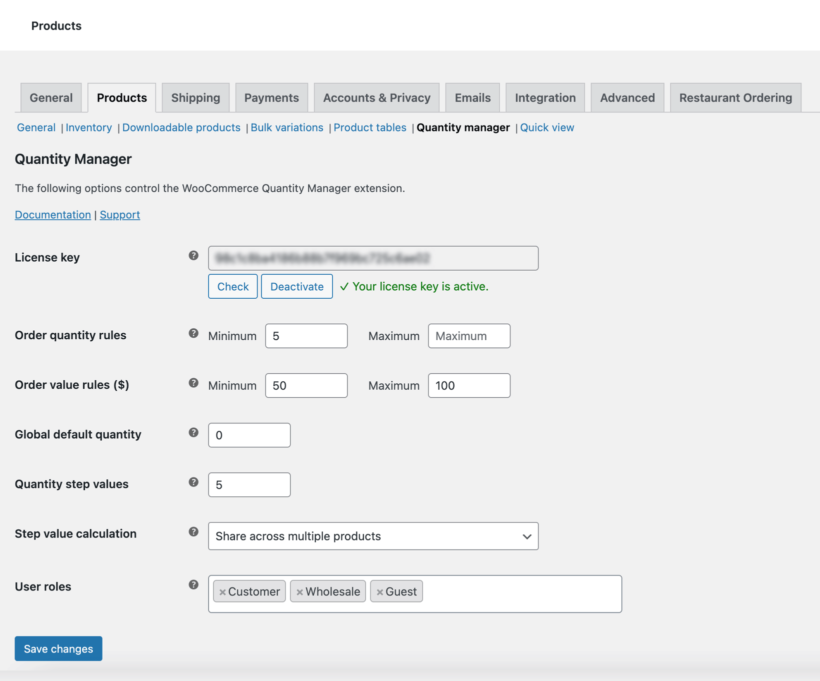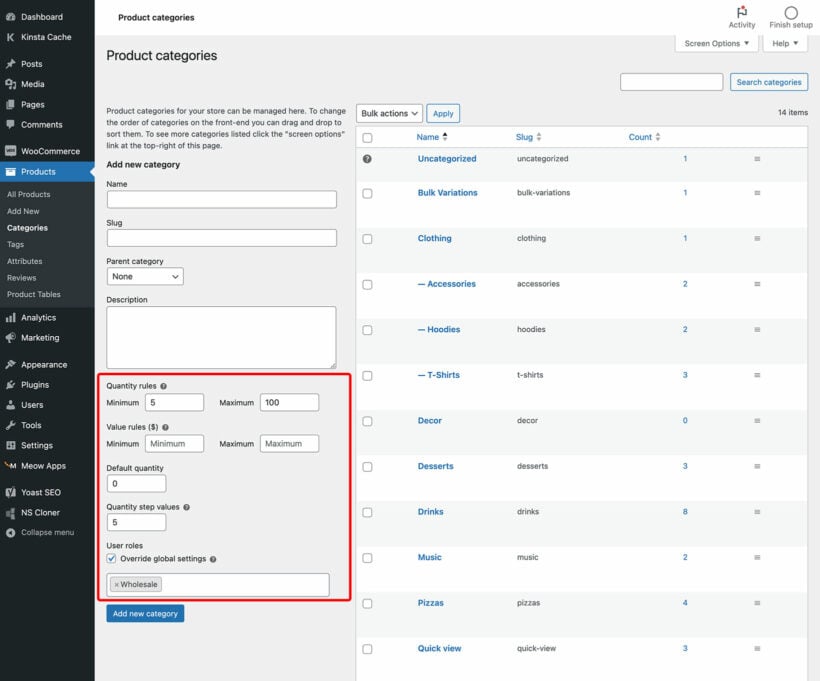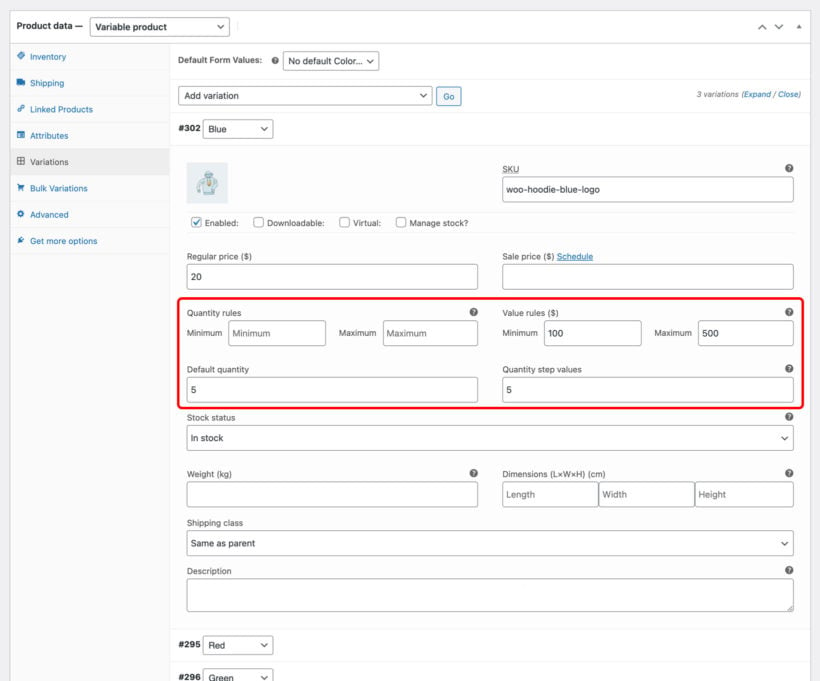WooCommerce fixed quantity: The basics

WooCommerce fixed quantity rules control the minimum and maximum product quantities that customers can buy on your online store. In this tutorial, I'll explain how WooCommerce fixed quantity works (with examples) and show you step-by-step how to create these rules on your ecommerce store.
What you need to know:
- Fixed quantities involve controlling how much of a product each customer can buy. This might be by selling products in fixed quantity groupings, or setting quantity minimums or maximums.
- The WooCommerce Quantity Manager plugin makes it easy to set up fixed quantity rules in your store.
By default, when a customer visits a product page on your WooCommerce store, the value on the quantity input dropdown is set to "1". This means that as long as the product is in stock, customers can add it to their cart in multiples of 1, i.e., 1,2,3,4, and so on, then head to the cart page to complete the checkout process.
While the default WooCommerce quantity value works well for some businesses, it isn't ideal for every store. And as a store owner, you might want to prevent customers from buying more or less of a specific product quantity from your store.
That's where WooCommerce fixed quantity rules come in.
What is WooCommerce fixed quantity?
WooCommerce fixed quantity rules are controls that require customers to select a specific or pre-determined quantity of a product from a WooCommerce store before heading to the checkout page. Adding fixed quantity restrictions makes it mandatory for customers to buy products in fixed amounts rather than choosing a different quantity. Fixed quantity rules are useful for bulk purchases, promotional deals, or managing inventory effectively.
Note that you can set minimum as well as maximum order quantity rules. Minimum quantity rules prevent your customers from buying less than a specific amount. In comparison, maximum quantity rules prevent customers from buying more than a specific quantity.
To illustrate this with an example: Let's say that your ecommerce store sells eggs by the dozen. If you set up a fixed quantity rule on your Woo store, customers must purchase eggs in multiples of 12. They cannot select a different quantity, such as an amount lower than 12 or any quantity that is not a multiple of 12 from the quantity dropdown. This means they can only buy eggs in quantities of 12, 24, 36, 48, etc.
WooCommerce doesn't include the option to set fixed quantity rules by default. You'll need to use a WooCommerce plugin add-on to add this functionality to your online store.
What is the difference between fixed and dynamic quantity in WooCommerce?
In WooCommerce, fixed quantity rules restrict customers — they can only select a pre-determined amount from the quantity field and head to the cart page to complete the checkout process. On the other hand, dynamic qty rules allow customers to choose any quantity they desire.
Overall, dynamic quantity rules provide more flexibility to customers, while fixed quantity rules add structure and control in the purchasing process.
Examples of products sold in fixed quantities
By now, you can probably think of many types of products commonly sold in fixed quantities. Here are the top examples:
Wholesale or bulk purchases
Typically, customers who purchase from wholesale stores buy products at an amount lower than the retail price. This makes sense to require customers to buy products in fixed quantities, such as packs of 10, 20, or 50. If you're using our WooCommerce Wholesale Pro plugin to build a standalone or hybrid B2B store, you may need to sell products in fixed quantities.
Bundle deals
Bundle deals or sets are a quintessential example of products sold in fixed quantities. Offering bundles are a popular marketing strategy to increase conversions and incentivize customers to buy more with attractive product combinations. With product bundles, customers are required to select a pre-determined number of items from the quantity dropdown field, like a set of 4 wine glasses or a pack of 6 pairs of socks.
Limited edition items
Limited edition products are prized for their scarcity and exclusivity. Using the fixed quantity rule, you can ensure that a specific number of units are available per customer. The item becomes unavailable once the customer adds the maximum quantity of the product to their cart. This helps to ensure fair distribution and prevent individual customers from buying out the entire stock.
Promotional offers
Promotions and offers help to encourage customers to buy more and increase conversions on ecommerce stores. Many online stores use plugins like WooCommerce Discount Manager to offer "Buy X, Get Y Free" deals or "Buy X for a fixed price" promotions to require customers to purchase a specific number of items to qualify for the quantity discount.
Subscription boxes
Subscription-based businesses typically follow a pre-determined schedule, delivering a specific quantity of items at regular intervals, typically monthly, quarterly, or annually — for example, a monthly delivery of a 12-pack of specialty coffee. Implementing the fixed quantity rule ensures that customers receive a consistent number of products with every subscription box order.
Event ticketing
Ticket scalping can be a significant challenge for event organizers. Some individuals may attempt to purchase many tickets to resell them later at higher prices. That's why many websites that sell tickets for events, courses, concerts, seminars, etc., enforce maximum quantity rules to limit the number of tickets a single customer is allowed to purchase. This helps to distribute tickets more evenly among interested attendees and discourages ticket scalping.
Pre-packed meal plans
Restaurants and meal delivery service businesses might use a plugin like WooCommerce Restaurant Ordering to offer pre-determined meal plan options. This also means that they need to require customers to purchase a fixed number of meals per week, such as a 10-meal plan, and need a fixed quantity plugin to enforce the quantity restrictions.
Craft supplies
Stores that sell craft supplies typically cater to customers that enjoy DIY projects, artwork, crafting, and other creative hobbies. However, craft supplies such as fabric, beads, or yarn often come in various shapes and sizes, which can make shipping and packaging challenging. Not to mention, the value of a single piece of string or thread may be too low to warrant the shipping and delivery costs. Adding a fixed quantity rule for minimum quantity orders helps ensure that stores can provide efficient and cost-effective shipping options.
Educational materials
Managing inventory is crucial for stores that sell educational materials, as they often deal with a wide range of textbooks, workbooks, and other resources. Publishers selling textbooks or educational resources might require educational institutions to purchase a fixed quantity of books or materials for a specific number of students.
Custom or personalized products
Personalized or customized items are usually uniquely tailored in small quantities for customers. However, it can be costly to create and manage inventory. Many stores that offer custom items, such as engraved pens or monogrammed towels, usually require customers to purchase a minimum fixed quantity to make the customization process more efficient and cost-effective.
WooCommerce Quantity Manager - the easy way to set up fixed quantities
WooCommerce Quantity Manager is a powerful plugin that lets you control product quantities and add fixed quantity rules to your WooCommerce store. It has lots of advanced quantity management features, such as the option to set minimum and maximum quantities, spending rules, defaults, step values, and more.
WooCommerce Quantity Manager is packed with plenty of features. The plugin lets you:
- Change the default order quantity for each product from "1" to a custom value of your choice.
- Set Min/Max product quantity controls for each product or order.
- Set a minimum amount for each order.
- Create order quantity increment values to force customers to buy products in multiples.
- Lots more.
And best of all, it's super easy for beginner and advanced WordPress users to use.
How to set up fixed quantities on your WooCommerce store
In this section, I'll show you how to configure WooCommerce Quantity Manager to create quantity restrictions on your WooCommerce store. I've also included the relevant screenshots to make it even easier for you to follow along.
Step 1: Plugin installation and activation
Like every other plugin, installing and activating WooCommerce Quantity Manager is the first step. Here's how to do this:
- Purchase the plugin and download the ZIP files to your computer.
- Navigate to your WordPress admin dashboard. Go to "Plugins" → "Add New" → "Upload Plugin".
- Click on the "Choose File" button. Then select the plugin zip file you downloaded earlier.
- Click on the "Install" button.
- Once the plugin is installed, click "Activate".
- Enter your license key to get the plugin to work. You can do this via the setup wizard, which automatically launches after you activate the plugin. Alternatively, head to WooCommerce"→ Settings → Products → Quantity Manager in your WordPress admin dashboard.
Step 2: Creating WooCommerce fixed quantity rules
There are four ways to create fixed quantity restrictions on your WooCommerce store:
- Globally: These rules will apply to all the products in your store.
- Per category: These rules will apply to products in specific categories in your store.
- Per simple product: These rules will apply to individual simple products (products without variations) in your store.
- Per variable product: These rules will apply to individual product variations in your store.
Note: The fixed quantity rules that you set will be applied based on a "Global" → "Category" → "Product" hierarchy. This means that category rules override global rules, while per-product rules override category and global rules.
Let's look at how to set these up in your store.
Global rules

- Navigate to "WooCommerce" → "Settings" → "Products" → "Quantity Manager" in your WordPress admin dashboard.
- In the "Order quantity rules" section, type in the minimum and maximum order amounts that customers can add to their carts.
- Next, type in the minimum and maximum order value (in dollar amounts) that customers can add to their carts in the "Order value rules" section.
- In WooCommerce, the default product quantity that customers can add to their cart is "1". Enter the new default quantity in the "Global default quantity" section if you want to change it.
- The "Quantity step values" field allows you to force customers to purchase products in specific quantity increments. WooCommerce sets this to "1" by default, but you can change it if you prefer. Note: You have to change it to whole number, you can't change it to decimal quantity.
- The "Step value calculation" section allows you to apply the quantity step values rules you selected earlier to individual products or across multiple products. Select your preferred option here.
- The "User role" setting allows you to apply the fixed quantity rules based on customers' specific user roles in WordPress. For example, if you run a hybrid B2B store that sells to wholesale and retail customers, you can apply the fixed quantity option only for wholesale customers. Retail customers will be able to select and purchase products in their preferred quantity.
- Finally, save the settings at the bottom of the page.
Category rules
If you've created multiple categories in your store, you can set different fixed quantity restrictions for each. Note that these settings will override the global settings you selected earlier.

- Go to Products → Categories in your WordPress admin dashboard.
- Click on the product category for which you want to update the fixed quantity amounts.
- Scroll down the page. In the "Order quantity rules" section, type in the min/max quantities that customers can add to their carts.
- Next, type in the minimum and maximum order value (in dollar amounts) that customers can add to their carts in the "Value rules" section.
- Update the default cart quantity, i.e., the quantity customers can add to their carts in the "Default quantity" field. Note: This is optional.
- Now, update the "Quantity step values" field to force customers to purchase products in specific quantity increments. Note: This setting is also optional. Also, you have to change it to whole number, you can't change it to decimal quantity.
- Finally, select "Update" to save your changes.
Simple product rules
Now, let's look at how to set fixed quantity rules for simple products. Note that these settings will override the global as well as category settings you selected earlier.

- Head to Products → All Products in your WordPress admin dashboard.
- Select the specific product for that you want to update the fixed quantity amounts.
- Scroll to the "Product data" module and click the "Inventory" tab.
- In the "Order quantity rules" section, type in the min/max quantities that customers can add to their carts.
- Next, type in the minimum and maximum order value (in dollar amounts) that customers can add to their carts in the "Value rules" section.
- Update the default cart quantity in the "Default quantity" field. Note: This is optional.
- Now, update the "Quantity step values" field to force customers to purchase products in specific quantity increments. Note: This is optional. Also, you have to change it to whole number, you can't change it to decimal quantity.
- Finally, scroll back up and select "Update" to save your changes.
Variable product rules
Now, let's look at how to set fixed quantity rules for product variations. Note that these settings will override the global and category settings you selected earlier.

- Go to Products → All Products in your WordPress admin dashboard.
- Select the specific product that you want to update the fixed quantity amounts.
- Scroll to the "Product data" module and click on the "Variations" tab.
- Click the "Edit" button for the product variation for which you want to add fixed quantity rules.
- In the "Order quantity rules" section, type in the min/max quantities that customers can add to their carts.
- Now, type in the minimum and maximum order value (in dollar amounts) that customers can add to their carts in the "Value rules" section.
- Update the default cart quantity, i.e., the quantity customers can add to their cart in the "Default quantity" field. Note: This is optional.
- Now, update the "Quantity step values" field to force customers to purchase products in specific quantity increments. Note: This is optional. Also, you have to change it to whole number, you can't change it to decimal quantity.
- Rinse and repeat: To add fixed quantity rules for the remaining product variations, click on the "Edit" button for each variation and follow steps 5-8.
- After you've added all the fixed quantity rules, scroll to the top of the screen. Then select "Update" to publish your settings.
Managing stock with WooCommerce fixed quantity rules
Selling products in fixed quantities is a stock management strategy that works well for many types of products for several reasons:
- It ensures smooth inventory management: Implementing fixed quantity rules gives you better control over inventory levels. Because customers can only purchase the pre-determined quantity you have set, it helps ensure you have enough inventory to fulfill orders. This reduces the risk of overselling or running out of stock.
- It optimizes order fulfillment: Having fixed quantity rules in place allows you to optimize your order shipping and delivery process. By ensuring that customers purchase items in specific quantities, you can streamline the picking, packing, and shipping operations. This can lead to faster order processing times and improved efficiency in fulfilling customer orders.
Overall, adding fixed quantity rules help to eliminate the frustration for both you and your customers when items become unavailable, leading to a smoother shopping experience and increased customer satisfaction.
Get the best WooCommerce fixed quantity plugin
Regardless of the type of product you sell, creating WooCommerce fixed quantity rules can help streamline your store's inventory management and order fulfillment. And while this feature isn't built into WooCommerce out-of-the-box, it's easy to add it to your store with the WooCommerce Quantity Manager plugin.
WooCommerce Quantity Manager is the best quantity control plugin to help you create fixed quantity rules while being super easy-to-use. With WooCommerce Quantity Manager, you can easily set minimum and maximum quantities, spending rules, step values and much more. Get the plugin today!